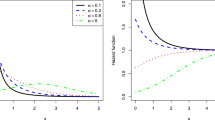Abstract
Many if not most lifetime distributions are motivated only by mathematical interest. Here, a new three-parameter distribution motivated mainly by lifetime issues is introduced. Some properties of the new distribution including estimation procedures, univariate generalizations and bivariate generalizations are derived. Two real data applications are described to show superior performance versus some known lifetime models.






Similar content being viewed by others
References
Adamidis A, Loukas S (1998) A lifetime distribution with decreasing failure rate. Stat Probab Lett 39:35–42
Barreto-Souza W, Cribari-Neto F (2009) A generalization of the exponential-Poisson distribution. Stat Probab Lett 79:2493–2500
Conti M, Gregori E, Panzieri F (1999) Load distribution among replicated web servers: a QoS-based approach. ACM SIGMETRICS Perform Eval Rev 27:12–19
Cordeiro GM, de Castro M (2011) A new family of generalized distributions. J Stat Comput Simul 81:883–898
Elhai JD, Calhoun PS, Ford JD (2008) Statistical procedures for analyzing mental health services data. Psychiatry Res 160:129–136
Eugene N, Lee C, Famoye F (2002) Beta-normal distribution and its applications. Commun Stat Theory Methods 31:497–512
Fricker C, Gast N, Mohamed H (2012) Mean field analysis for inhomogeneous bike sharing systems. In: Proceedings of the 23rd international meeting on probabilistic, combinatorial, and asymptotic methods for the analysis of algorithms, pp 365–376
Ginebra J, Puig X (2010) On the measure and the estimation of evenness and diversity. Comput Stat Data Anal 54:2187–2201
Kuş C (2007) A new lifetime distribution. Comput Stat Data Anal 51:4497–4509
Lawless JF (2003) Statistical models and methods for lifetime data. Wiley, New York
Maller RA, Zhou X (1995) Testing for the presence of immune or cured individuals in censored survival data. Biometrics 51:1197–1205
Ortega EMM, Cordeiro GM, Hashimoto EM (2011) A log-linear regression model for the beta-Weibull distribution. Commun Stat Simul Comput 40:1206–1235
Prudnikov AP, Brychkov YA, Marichev OI (1986) Integrals and series, volumes 1, 2 and 3. Gordon and Breach Science, Amsterdam
R Development Core Team (2012) R: a language and environment for statistical computing. R foundation for statistical computing, Vienna, Austria
Silva RB, Barreto-Souza W, Cordeiro GM (2010) A new distribution with decreasing, increasing and upside-down bathtub failure rate. Comput Stat Data Anal 54:935–944
Singh H, Misra N (1994) On redundancy allocations in systems. J Appl Probab 31:1004–1014
van der Heijden PGM, Bustami R, Cruyff MJLF, Engbersen G, van Houwelingen HC (2003) Point and interval estimation of the population size using the truncated Poisson regression model. Stat Model 3:305–322
Xu S, Hu Z (2011) Mapping quantitative trait loci using the MCMC procedure in SAS. Heredity 106:357–369
Acknowledgments
The authors would like to thank the two referees and the Editor for careful reading and for their comments which greatly improved the paper.
Author information
Authors and Affiliations
Corresponding author
Appendix
Appendix
The calculations of the paper require the following lemmas.
Lemma 1
If a random variable \(X\) has the GEP distribution then
Proof
Using the series expansion, (5), we can write
The result follows by the definition of the incomplete gamma function. \(\square \)
Lemma 2
If a random variable \(X\) has the GEP distribution then
Proof
Using the series expansion, (5), we can write
The result follows by the definition of the incomplete gamma function.
Rights and permissions
About this article
Cite this article
Nadarajah, S., Cancho, V.G. & Ortega, E.M.M. The geometric exponential Poisson distribution. Stat Methods Appl 22, 355–380 (2013). https://doi.org/10.1007/s10260-013-0230-y
Accepted:
Published:
Issue Date:
DOI: https://doi.org/10.1007/s10260-013-0230-y




